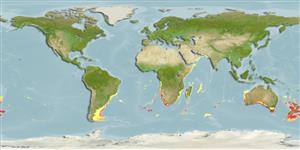Classification / Names
Common names from other countries
Main reference
Size / Weight / Age
Max length : 30.0 cm SL male/unsexed; (Ref. 57469)
Environment
Marine; bathydemersal; depth range 35 - 1000 m (Ref. 9563), usually 400 - 750 m (Ref. 9563)
Climate / Range
Deep-water, preferred 17°C (Ref. 107945); - 55°S (Ref. 57469)
Distribution
Circumglobal in southern temperate waters. Southeast Atlantic: South Africa, from Cape Columbine to False Bay; also reported from Tristan da Cunha and Gough Island (Ref. 11228). Southwest Atlantic: Argentina. Southwest Pacific: Australia and New Zealand (Ref. 5755).
Countries | FAO areas | Ecosystems | Occurrences | Introductions
Short description
IUCN Red List Status (Ref. 115185)
Threat to humans
Harmless
Human uses
More information
Common namesSynonymsMetabolismPredatorsEcotoxicologyReproductionMaturitySpawningFecundityEggsEgg development
ReferencesAquacultureAquaculture profileStrainsGeneticsAllele frequenciesHeritabilityDiseasesProcessingMass conversion
Tools
Special reports
Download XML
Internet sources
Estimates of some properties based on models
Phylogenetic diversity index
PD50 = 1.0002 many relatives (e.g. carps) 0.5 - 2.0 few relatives (e.g. lungfishes)
Trophic Level
3.6 ±0.53 se; Based on food items.
Resilience
Medium, minimum population doubling time 1.4 - 4.4 years (Preliminary K or Fecundity.)
Vulnerability
Moderate vulnerability (44 of 100)
Price category
